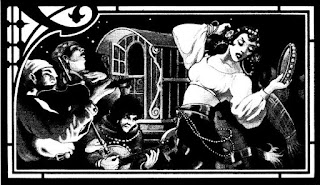
Characters:
Xue Lingsu (Purple Cavern Sect)
Xi Kang(Affiliated with Mr. Red Claw)
Zhi Zhu (No Sect)
Long Shu (Purple Cavern Sect)
Min (Purple Cavern Sect)
Rong (Tree-Dwelling Nun Sect)
Jia (Long Shu's snake demon wife)
Nuan (Xi Kang's disciple)
The party headed to Mystic Sword Temple where Lady Plum Blossom had gone to destroy what remained of the sect. When they arrived they found piles of dead bodies and learned that Purple Cavern Sect had won (though their numbers had been reduced to 144). Lady Plum Blossom issued an order for all members of her sect to kill any Mystic Sword disciples on site and the party aided in searching the temple halls.
In Lady White Blade's bedroom they found a small hidden compartment with a wall scroll that contained the Prophecy of the Calamity, these were the last words of General Dou Lun (an ancestor of Lady White Blade) who died at the battle of Yu Zhing when northern Hai'an fell to the empire 97 years ago. It read:
When the Calamity Star rejoins I will be reborn. My skin will be marked by the birds of paradise flower and I will reclaim The Empire for the Daolin people.The Calamity Star was a body in the sky that fragmented into three parts on the night of General Dou Lun's death and it rejoined seven years ago. Searching further they found orders issue by Lady White Blade instructing her disciples to seek information on the The Calamity Star's possible place of birth. There was a report that claimed it may have been in the Kushen Basin or in a village on Mount Hai'an called Buak. There were also orders to kill Zhi Zhu. In the library they found a number of manuals containing Mystic Sword Temple techniques.
Lady Plum Blossom told Lingsu to copy the manuals and then she presented them with a letter she received from Bronze Master that had been issued to all the sect leaders. It was an invitation to a competition in Zun City on the first day of the Ghost Festival (in about two months). It stated that Lingsu, Long Shu and Min had found the Phoenix Crown and come into possession of the Wind Saber of Sunan. In the interest of the greater good, they had agreed to allow their ownership be settled during the competition, with the victor rightfully gaining both items. The party had agreed to none of this and had never publicly stated had either the crown or the sword.
Lady Plum Blossom discussed their options and they considered making forgeries to present at the competition. Ultimately they settled on issuing a letter of their own to all the sects. The letter called for the establishment of a committee to form the rules of the competition. In their letter they nominated All the Orthodox Sect leaders, Lady Plum Blossom, Strange Phoenix, and the leaders of Majestic Lion and Zhe Valley. In addition they sent an anonymous letter to the Demon Moon Cult informing them that the competition was to take place and that a committee was to meet to determine the rules.
The purpose of the letter was to take the rules crafting out of the hands of Bronze Master alone. It was also done to create conflict between the participants and to hopefully delay the event, which would give them more time to secure the safety of the Wind Saber. They decided to seek someplace safe to place the sword but first set out for Buak to learn what they could about the Calamity Star.
| MYSTIC SWORD TEMPLE |
When they went north they took the prophecy of the Calamity Star scroll with them to Mount Hai'an sect headquarters (which was on the way). They met with Jinghui, the leader of Mount Hai'an and presented the scroll to her. She was cold and a bit hostile. Though she never threatened to kill them, it was clear she deemed Purple Cavern an unorthodox sect worthy of death so the players left once they had passed her the prophecy.
As they traveled through the mountain, Zhi Zhu checked to see if they were being followed and spotted four figured in black trailing them. Eventually they came parallel with the party and Zhi Zhu saw one of them change into the clothing of a Kushen Tribesmen. She eavesdropped and learned they were planning an ambush where the men in black would act as though they were attacking the Kushen and he would shout for help.
Armed with this knowledge the party allowed the ambush to unfold. They found their opponents but up a mild fight, with one of them using a variant of Endless Arc of the Spear to wound the party with a green ring of Qi energy. Soon the party had the upper hand and dispatched their foes. Lingsu was able to determine that these were Yao, martial heroes who served the emperor and were completely loyal after having their hearts cut out and placed in a box. The Kushen said his name was Tartu and that the Yao had been after him because he knew where their lacquered heart boxes were kept. To be safe the party chopped off the heads and limbs of the Yao. Tartu said they would still come back and tried to secure their trust but knowing about the ambush they chose to interrogate him.
Zhi Zhu pinned Tartu with Arms of Silk and they threatened to poison him if he didn't speak. Eventually he revealed that he was part of an ambush but only because the Emperor's grand councilor had taken his sister as a concubine and threatened to kill her. He also told them the Yao were planning a second attack that night and he was supposed to drug them beforehand. The party bound him, gagged him and took him as a prisoner. They then set out for Buak once more.
This is where the session ended.




























